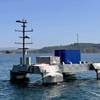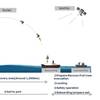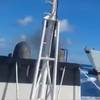LR Guidance on Partial Filling of LNG Tanks
The guidelines adopt a ‘comparative’ approach which involves comparing a proposed design with one for an LNG tanker of 135,000 to 140,000 cu m with conventional tank shape and size to ascertain the ability of the containment system to withstand the sloshing loads it is likely to experience based on the proposed trading pattern of the vessel.
This approach was pioneered by Lloyd’s Register in association with the Norwegian maritime research institute MARINTEK and containment system designer GazTransport & Technigaz during a research project completed in early 2003 to investigate the effects of sloshing in partially-filled LNG membrane tanks based on model experiments. The key advantage of the comparative approach is that it eliminates much of the uncertainty associated with the application of more traditional strength assessment techniques for such structures. This approach is now becoming the industry’s standard method for assessing the impact of sloshing loads for partially-filled or larger LNG tankers of up to around 250,000 cu m.
A key feature of the model tests carried out at MARINTEK was the use of a five-degree-of-freedom motion sloshing rig simulating cargo tank motions in irregular waves – a more accurate means of recreating the sea states an LNG tanker is likely to
encounter, giving a better reflection of the true sloshing loads experienced and ultimately leading to enhanced safety for membrane-type LNG tankers.
“These guidelines are based on long in-service experience of conventional LNG tankers and groundbreaking, in-depth research,” says Tony Bingham, Global LNG Business Manager, Lloyd’s Register. “The conclusions reached and the resulting guidelines we have issued will serve to further help enhance LNG ship safety, building on the industry’s experience of vessels of conventional size and giving us the basis for moving forward with the new, larger vessel designs being built by shipyards in the Far East.”
Lloyd’s Register is the chosen classification society for four of the eight large LNG tankers of more than 200,000 cu m ordered for the Qatargas project, to be built at Daewoo Shipbuilding & Marine Engineering.











